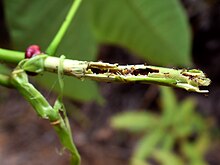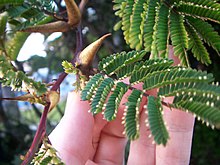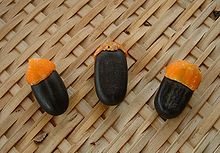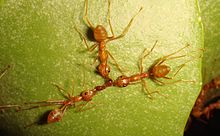Myrmecophyte

Myrmecophytes (
Mutualism

Myrmecophytes share a mutualistic relationship with ants, benefiting both the plants and ants. This association may be either facultative or obligate.[3]
Obligate
In obligate mutualisms, both of the organisms involved are interdependent; they cannot survive on their own. An example of this type of mutualism can be found in the plant genus Macaranga. All species of this genus provide food for ants in various forms, but only the obligate species produce domatia.[1] Some of the most common species of myrmecophytic Macaranga interact with ants in the genus Crematogaster. C. borneensis have been found to be completely dependent on its partner plant, not being able to survive without the provided nesting spaces and food bodies. In laboratory tests, the worker ants did not survive away from the plants, and in their natural habitat they were never found anywhere else.[4]
Facultative
Facultative mutualism is a type of relationship where the survival of both parties (plant and ants, in this instance) is not dependent upon the interaction. Both organisms can survive without the other species. Facultative mutualisms most often occur in plants that have
Structural adaptations

Domatia
Domatia can also be found within the

Food bodies
Some plants produce food bodies for use by other organisms. These small
Food Bodies
|
Main Nutrient Contained
|
Plant Genus
|
Location on Plants
|
| Beltian bodies | Protein | Acacia | Leaflet tips |
| Beccarian bodies | Lipids | Macaranga | Young leaves |
Pearl bodies |
Lipids | Ochroma | Leaves and stems |
| Müllerian bodies | Glycogen | Cecropia | Petiole of the leaf |

Extrafloral nectaries
Ant-plant interactions
Ants as pollinators
Unlike their

Ants and seed dispersal
Ants feeding plants
A recent study by Chanam et al.[15] showed that plants bearing domatia can be favoured even before the establishment of a specialised protection-based symbiosis, as nutritional benefits can be provided by a motley set of domatia residents that could include multiple species of ant (including protective, non-protective and even plant-damaging species such as Crematogaster dohrni) as well as other invertebrates, including as arboreal earthworms. Only some individuals of the myrmecophyte Humboldtia brunonis (found in the Western Ghats of India) bear domatia on some of their branches, while all individuals produce extrafloral nectar. Each domatium is formed by modified swollen and hollow internodes. These domatia have a self-opening slit that allows access to the domatium interior and are prone to interloping residents (including many species of non-protective ants and the arboreal earthworm Perionyx pullus) in addition to the protective ants.

Earlier studies established that domatia-bearing H. brunonis plants have greater fruit set, hence greater reproductive success, than H. brunonis plants without domatia. Plant tissues near domatia received 17% and 9% of their nitrogen from the ants (protective and non-protective) and the earthworm respectively. The absorbed nutrients also travelled to distant branches; hence, fruit set was not different between branches with and without domatia. This study demonstrated that non-protective interlopers in the domatia still contribute to the greater wellbeing of the plant by contributing to plant nutrition.
Ants as defense
Since plants provide essential
See also
- Ant garden
- List of symbiotic relationships
Notes
- ^ a b c d Speight, Hunter & Watt 2008
- ^ Wilson 1971
- ^ a b c d e f g Koptur 1991
- ^ Fiala, Maschwitz & Pong 1991
- ^ a b c d Janzen 1966
- ^ a b c Jebb 1991
- ^ a b c d e f g h i Rico-Gray & Oliveira 2007
- ^ Heil et al. 2004.
- ^ Heil, Rattke & Boland 2005.
- ^ Gonzalez-Teuber & Heil 2009.
- ^ Beattie & Hughes 2002
- ^ Peakall, Handel & Beattie 1991
- PMID 22590524.
- ^ Benzing 1991
References
- Beattie, Andrew J.; Hughes, Lesley (2002). "Ant-plant interactions". In Herrera, Carlos M.; Pellmyr, Olle (eds.). Plant-Animal Interactions. Malden, MA: Blackwell Publishing. pp. 211–235.
- Benzing, David H. (1991). "Myrmecotrophy: origins, operation, and importance". In Huxley, Camilla R.; Cutler, David F. (eds.). Ant-Plant Interactions. New York, NY: Oxford University Press. pp. 353–373. ISBN 0-19-854639-4.
- Fiala, Brigitte; Maschwitz, Ulrich; Pong, Tho Yow (1991). "The association between Macaranga trees and ants in South-east Asia". In Huxley, Camilla R.; Cutler, David F. (eds.). Ant-Plant Interactions. New York, NY: Oxford University Press. pp. 263–270. ISBN 0-19-854639-4.
- Gonzalez-Teuber, M.; Heil, M. (2009). "The Role of Extrafloral Nectar Amino Acids for the Preferences of Facultative and Obligate Ant Mutualists". Journal of Chemical Ecology. 35 (4): 459–468. S2CID 30114793.
- Heil, M.; Baumann, B.; Kruger, R.; Linsenmair, K.E. (2004). "Main nutrient compounds in food bodies of Mexican Acacia ant-plants". Chemoecology. 14: 45–52. S2CID 24186903.
- Heil, M.; Rattke, J.; Boland, W. (2005). "Postsecretory hydrolysis of nectar sucrose and specialization in ant/plant mutualism". Science. 308 (5721): 560–563. S2CID 18065410.
- Janzen, D. H. (1966). "Coevolution of mutualism between ants and acacias in Central America". Evolution. 20 (3): 249–275. PMID 28562970.
- Jebb, Matthew (1991). "Cavity structure and function in the tuberous Rubiaceae". In Huxley, Camilla R.; Cutler, David F. (eds.). Ant-Plant Interactions. New York, NY: Oxford University Press. pp. 374–389. ISBN 0-19-854639-4.
- Koptur, Suzanne (1991). "Extrafloral nectarines of herbs and trees: modeling the interaction with ants and parasitoids". In Huxley, Camilla R.; Cutler, David F. (eds.). Ant-Plant Interactions. New York, NY: Oxford University Press. pp. 213–230. ISBN 0-19-854639-4.
- Peakall, Rod; Handel, Steven N.; Beattie, Andrew J. (1991). "The evidence for and importance of ant pollination". In Huxley, Camilla R.; Cutler, David F. (eds.). Ant-Plant Interactions. New York, NY: Oxford University Press. pp. 421–429. ISBN 0-19-854639-4.
- Rico-Gray, Victor; Oliveira, Paulo S (2007). The Ecology and Evolution of Ant-Plant Interactions. Chicago, IL: University of Chicago Press. pp. 42–51, 101–109.
- Speight, Martin R.; Hunter, Mark D.; Watt, Allan D. (2008). Ecology of Insects (2nd ed.). West Sussex, UK: Wiley Blackwell Publications. pp. 212–216.
- Wilson, Edward O. (1971). The Insect Societies. Belknap Press. ISBN 978-0-674-45490-3.
